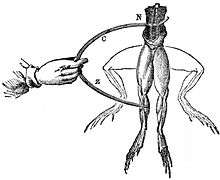Galvanism


In biology, galvanism is the contraction of a muscle that is stimulated by an electric current. In physics and chemistry, it is the induction of electrical current from a chemical reaction, typically between two chemicals with differing electronegativities.
History
The effect was named after the scientist Luigi Galvani, who investigated the effect of electricity on dissected animals in the 1780s and 1790s. In 1786, he discovered that, when a frog's legs are touched by both a copper probe and a piece of iron at the same time, they then twitch just as if an electric current were present. He originally attributed this to a vital fluid (an old theory of biology that is no longer accepted by science). He later changed his mind and theorized that the action was caused by "animal electricity"—in other words, electricity generated biologically. Both theories were wrong, as proved by Alessandro Volta, who believed that it was the presence of two different metals that was generating the electricity. Volta proved his theory by creating the first chemical electric battery.[2]
Galvani has been called the father of electrophysiology. The debate between Galvani and Volta "would result in the creation of electrophysiology, electromagnetism, electrochemistry and the electrical battery."[3]
On March 27, 1791, Galvani published a book about his work on animal electricity. It contained comprehensive details of his 11 years of research and experimentation on the topic.[4]
Giovanni Aldini (Luigi's nephew) performed a famous public demonstration of the electro-stimulation technique of deceased limbs on the corpse of an executed criminal George Foster at Newgate in London in 1803.[5][6] The Newgate Calendar describes what happened when the galvanic process was used on the body:
On the first application of the process to the face, the jaws of the deceased criminal began to quiver, and the adjoining muscles were horribly contorted, and one eye was actually opened. In the subsequent part of the process the right hand was raised and clenched, and the legs and thighs were set in motion.[7]
Modern studies
The modern study of galvanic effects in biology is called electrophysiology, the term galvanism being used only in historical contexts.
Popular culture
The term is also used to describe the bringing to life of organisms using electricity, as popularly associated with, but only explicitly stated in the 1831 revised edition of, Mary Shelley's work Frankenstein, and people still speak of being "galvanized into action."
It is also used by Car Seat Headrest in the song "Nervous Young Inhumans" from Twin Fantasy, in which he (incorrectly) uses the term 'Galvanistic', instead of 'Galvanic'.
See also
- Electrohomeopathy
- Bioelectromagnetics
- Electrotherapy
- Electrotherapy (cosmetic)
- Frankenstein
- Hallerian physiology, for a counter-theory to Galvanism
References
- ↑ David Ames Wells, The science of common things: a familiar explanation of the first principles of physical science. For schools, families, and young students., Publisher Ivison, Phinney, Blakeman, 1859, 323 pages (page 290)
- ↑ Edwin James Houston, "Electricity in Everyday Life", Chapter XXII. P. F. Collier & Son, 1905.
- ↑ Cajavilca, Christian, Joseph Varon, and George L. Sternbach. "Luigi Galvani and the Foundations of Electrophysiology." Resuscitation, vol. 80, no. 2, 2009., pp. 159-162doi:10.1016/j.resuscitation.2008.09.020.
- ↑ Montillo, Roseanne. The Lady and her Monsters. Harper Collin. pp. 49-50.
- ↑ "AIM25 text-only browsing: Royal College of Surgeons of England: Aldini, Giovanni: Notebook". Aim25.ac.uk. Retrieved 2012-08-05.
- ↑ "Early Nineteenth century electrochemistry". Retrieved 21 October 2010.
- ↑ The Newgate Calendar - George Foster Executed at Newgate, 18th of January, 1803, for the Murder of his Wife and Child, by drowning them in the Paddington Canal; with a Curious Account of Galvanic Experiments on his Body
External links
| Wikimedia Commons has media related to Galvanism. |